
By Lenore Macdonald
The scent of roasting green chiles, aspens turning shades of brilliant gold, crisp air and light, and four fabulous art exhibitions: it must be autumn in Taos.
Taos has emerged from its sleepy covid slumber.
The town’s four major art institutions: The Harwood Museum, Taos Art Museum, Millicent Rogers Museum, and Couse-Sharp Historic Site are offering five outstanding special exhibitions this fall. In a short period of time over a few short city blocks plus a ten-minute car ride, you can immerse yourself in a specially curated selection of works by Taos Society of Art co-founder Bert Geer Phillips; enjoy the magnificent canvases of Joseph Henry Sharp on view in his historic, restored studio; be moved by santero (“saint maker”) Nicholas Herrera’s works; explore recent discoveries at famed artist Nikolai Fechin’s home; and, reflect on Lady Dorothy Brett’s time in Taos.
At the Couse-Sharp Historic Site (CSHS) in the Lunder Research Center Porter Gallery: Vecinos y Amigos/Bert Geer Phillips and His Neighbors
On view September 13, 2024 until February 28, 2025
Bert Phillips’ life in Taos is well documented. In the summer of 1898, he and fellow student Ernest Blumenschein came to Taos on a painting trip, a legendary event that has always marked the origin of the Taos Society of Artists (TSA). He married and remained in the town until shortly before his death in 1956.
 Will Connell, Photo portrait of Bert Philips in his studio in Taos, New Mexico, 1932.
Will Connell, Photo portrait of Bert Philips in his studio in Taos, New Mexico, 1932.
Vecinos y Amigos: Bert Geer Phillips and his Neighbors has a different, but complementary, task. “Our exhibition seeks to expand our knowledge of the context of those few paintings in which people in the Hispanic community modeled, to identify them, and to enrich Bert’s stories with theirs,” said Davison Koenig, CSHS executive director and curator. “And we’re fortunate that it’s also a beautiful show featuring some of his best work, as well as key objects and archival material.”

Bert Geer Phillips, Lady, Please Buy One Chicken, 1935, oil on canvas, 38×25.5 in. Courtesy of Albuquerque Museum, Albuquerque High School Collection, 1985 General Obligation Bonds.
Guest Curator James C. Moore added, “These paintings are not portraits as such, but imaginative tableaux in which people served as actors in stories that Phillips felt would have success in broadening his reputation on the exhibition circuit.” He said Phillips also kept in mind that his buyers were part of a mainstream US public fascinated by, but largely ignorant of, the cultures of the American Southwest.
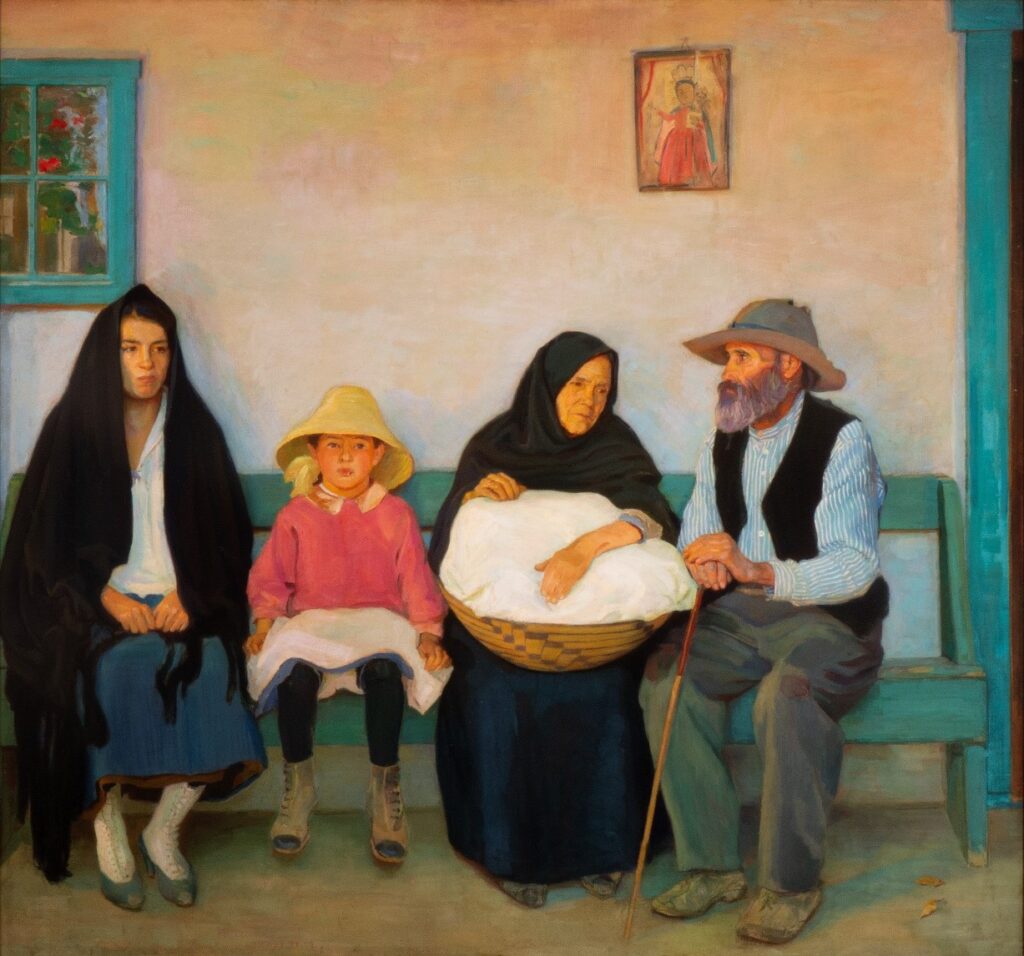
Bert Geer Phillips, Our Washerwoman’s Family – New Mexico, circa 1918. Oil on canvas, 40 1/2 x 41 5/8 in. New Mexico Museum of Art, Gift of Governor and Mrs. Arthur Seligman, before 1930, 537.23P.
When he first arrived in Taos, Phillips exhibited bigotry toward many of his neighbors, famously provoking a deadly riot when he refused to remove his hat for a religious procession on the street. In time, “He learned to appreciate the area’s cultural milieu and foster more respectful relationships,” Koenig noted.

Bert Geer Phillips, The Santero, ca. 1918, oil on canvas, 30 x 26 in. Courtesy of American Museum of Western Art.
“Paintings of Hispanic subjects are rare within the work of the TSA,” Moore said. “Research into the models’ families and recognition of who they were allows a new understanding of Bert’s working method and greater insight into how paintings were conceived to fit the existing market—and appeal to the stereotypes held by potential buyers.”
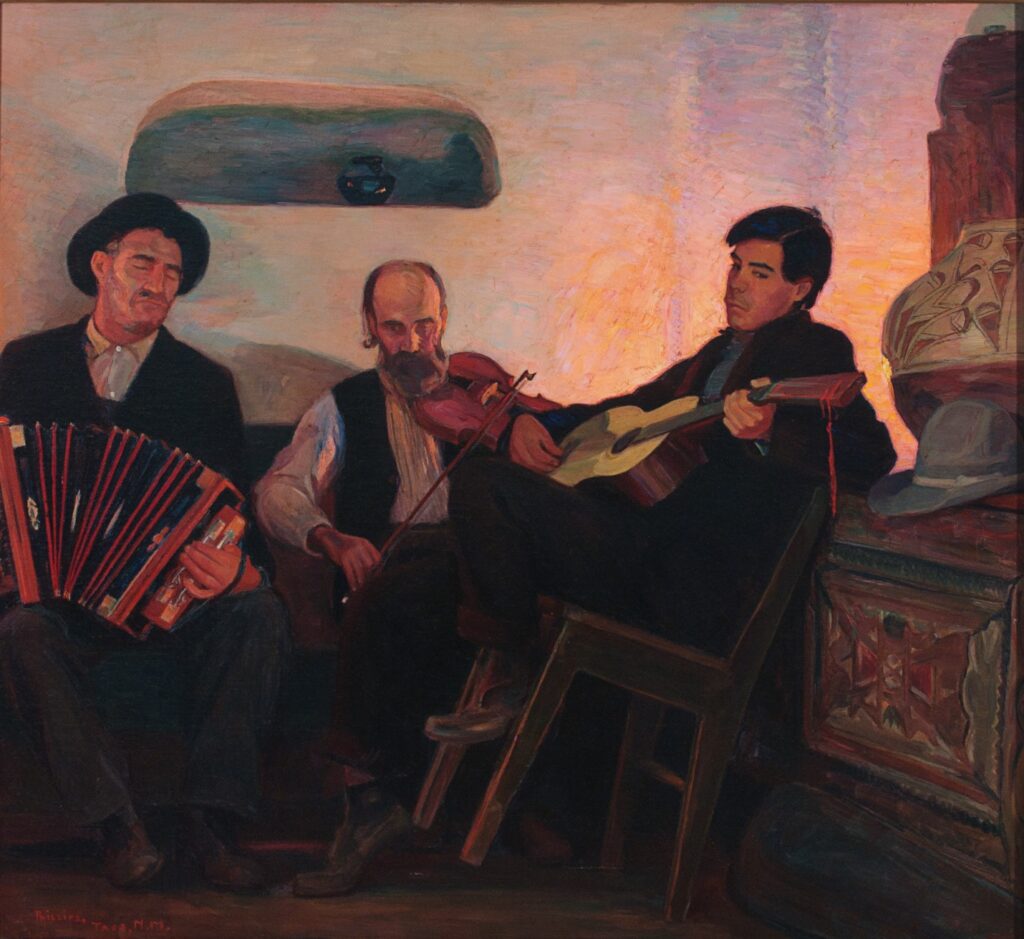
Bert Geer Phillips, Three Musicians of the Baile, circa 1920 – 1921, oil on canvas, 39 1/2 x 42 in. Collection of the New Mexico Museum of Art. Gift of Governor and Mrs. Arthur Seligman, 1929 (329.23P). Photo by Addison Doty.
“Knowing these people gives significance to those who have long been anonymous, broadening our view of the larger social dynamic of Taos,” Koenig said. He lauded CSHS Site Coordinator Jake Cisneros, archive staff, and members of the organization’s Hispano Advisory Council that Cisneros chairs, for their research into the models, their descendants, Phillips’s life, and his paintings, including sacred objects depicted in them. Koenig concluded, “Their work has broadened the scope of The Lunder Research Center here on our campus, and is a perfect illustration of the kind of enrichment of narratives that we aim for.”
Click here for more information.
At the Couse-Sharp Historic Site (CSHS)– Joseph Henry Sharp: The Life and Work of an American Legend
On view through December 31, 2024
This exhibition, installed in the free-standing studio Sharp built in 1915, covers Joseph Henry Sharp’s entire career and includes numerous works of art, correspondence, and Native American artifacts that he collected, and which appeared in his paintings. Each summer the exhibition is refreshed with new artwork and ephemera.
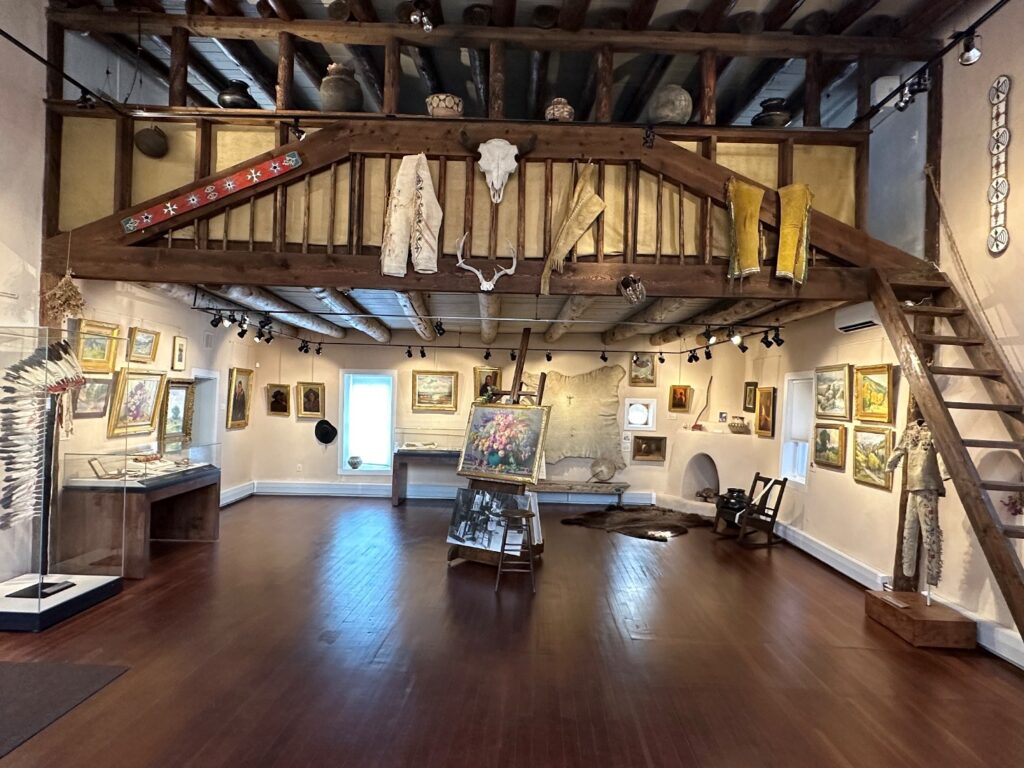
The recently restored Joseph Henry Sharp Studio at the Couse-Sharp Historic Site in Taos, New Mexico. Pot courtesy of the Couse-Sharp Historic Site.
Sharp was one of the founding members of the Taos Society of Artists (TSA), also comprised of E. Irving Couse, Oscar E. Berninghaus, W. Herbert Dunton, Ernest Blumenschein and Bert Phillips. Sharp was the first of the “Taos Six,” as the founding members are known, to visit Taos in 1893, and is often referred to as the “Spiritual Father” of the TSA. In the years that followed the members of the TSA created one of the most influential art colonies in the United States, making Taos an international art center. Responding to the light and color of northern New Mexico, these artists created a new American art lexicon based on the unique combination of Native American, Hispanic and Western Anglo-American cultures, set in the dramatic Taos landscape.

Joseph Henry Sharp, New Mexico Sand, Sage, Cedar, Clouds, and Mountains, ca. 1930s, Oil on canvas, 40 x 48 in. Loan courtesy TAMUK H.R. Smith Ranch, LLC/King Ranch Institute for Ranch Management/Texas A&M University-Kingsville Foundation.
Although rendered deaf at an early age, Sharp possessed a courageous character and a positive disposition. His gentle demeanor and sense of humor endeared him to his Native models, colleagues and friends. Sharp quickly gained notoriety for the visual accuracy of his paintings that deftly captured the soul and humanity of his Native models, representing a shift from prevailing attitudes toward the American Indian. For many years he divided his time between Montana and Taos. During his lengthy stays at his cabin home at Crow Agency in Montana, Sharp painted many of the Native survivors of the Battle of the Little Bighorn, including members of the Cheyenne, Arapaho, Lakota, Blackfoot, and Crow tribes. Acutely aware of their rapidly changing customs and practices, and sought to record them lest they disappear entirely. As Sharp explained in his own words:
“[I try] to present the Indian as he is…mentally as well as physically; not as ephemeral fiction has delighted to picture him, but as a human being….”

Joseph Henry Sharp, Strikes His Enemy Pretty, 1906, Oil on canvas, 14” x 20”, Loan courtesy Tim and Ingmarie McElvain.
This is the first permanent exhibition dedicated to the indomitable spirit of J.H. Sharp and the vision and compassion he shared with the world. The exhibition in the spacious two-story adobe studio he designed and built allows visitors to stand on the site where he created some of his greatest works, read the humor and tenderness in his personal letters, be surrounded by the Native artifacts he collected, and be inspired by his artistic vision.
Click here for more information.
At The Harwood Museum of Art—Nicholas Herrera: El Rito Santero
On view through September 21, 2024, through June 1, 2025
Nicholas Herrera: El Rito Santero is a glimpse into the life and works of master santero, or saint maker, Nicholas Herrera. Herrera, born and raised in El Rito, New Mexico, is a folk artist whose family was among the earliest settlers in the region. Claiming Spanish, Native American, and Mexican ancestry, Herrera identifies as mestizo and descends from farmers and outlaws, landowners and soldiers, craftsmen and artists. This is the first solo museum exhibition of Nicholas Herrera, an artistic legend in his own time.
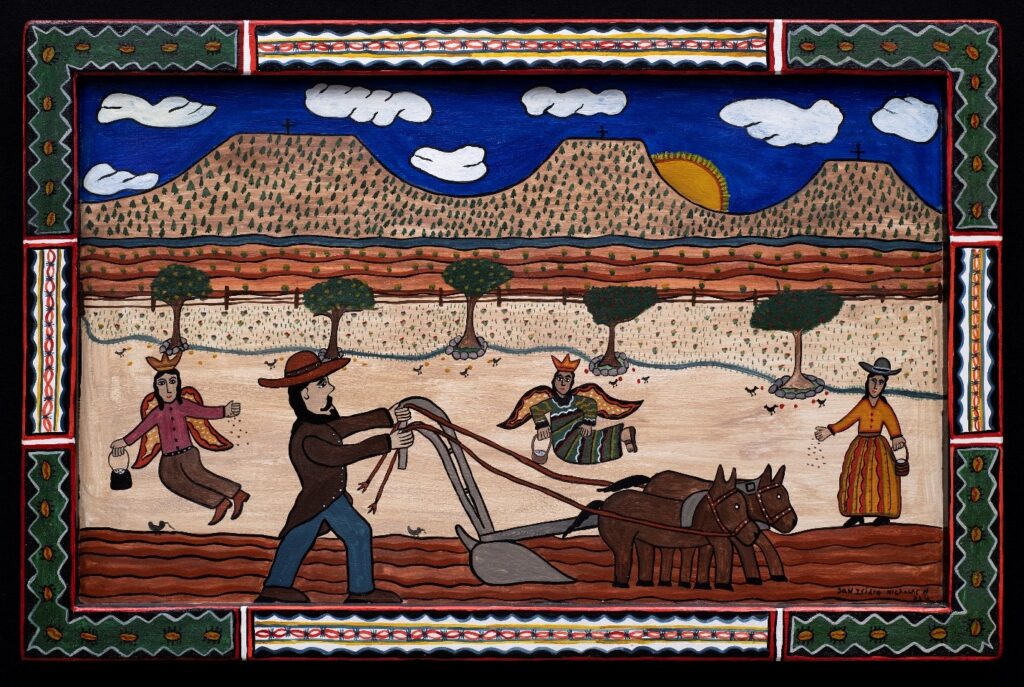
Nicholas Herrera, San Isidro, 2016, wood with natural pigments, 24 x 36 inches. Courtesy of Tia Collection, Santa Fe, NM. James Hart Photography.
He grew up around the Spanish traditions of Northern New Mexico and came of age with a fast-paced lifestyle that resulted in a serious car accident at the age of 26. After awakening in the hospital and recovering from a coma, Herrera felt called to become a saint maker.

Nicholas Herrera, La Virgen de Guadalupe, 1998, hand carved wood with natural pigments, 22 x 7.25 x 6.75 inches. Courtesy of Evoke Contemporary.
As a modern santero, Herrera creates bultos (three-dimensional works), retablos (two-dimensional works), and large-scale mixed media works, many of which detail rich and often challenging chapters in his storied life. Through varied mediums, this exhibition surveys Herrera’s personal identity, family history, relationship to place, and political ideology. Still a “village artist,” Herrera continues to reside, regenerate, and create on the land of his family.
Click here for more information.
At the Taos Art Museum (TAM): Forsaken Objects and Untold Stories
Photographs by Zoë Zimmerman
On view through January 12, 2025 in the Fechin House, Taos Art Museum.
Dispatch From Taos readers know that the Taos Art Museum is a very special place. It was the home of Russian artist Nicolai Fechin, his wife Alexandra, and daughter Eya. The museum’s primary aims are to improve awareness of the works and patronage of Taos artists and to nurture local artistic development. It also presents special exhibitions from time to time. This autumn we are invited indulge some our more voyeuristic tendencies.
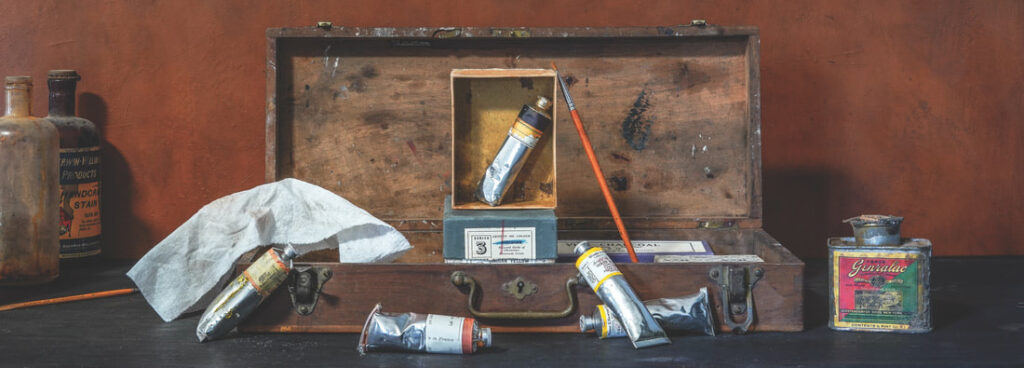
Zoë Zimmerman, Paint Box, 2023. Courtesy of Zoë Zimmerman and the Taos Art Museum.
Photographer Zoë Zimmerman’s unique ability to take breathtaking photographs that capture vulnerability, intimacy, and nostalgia is ever-present in this exhibition of photographs of the Fechin family’s ephemera, a treasure trove of personal items that were left untouched in the basement of the Fechin House. The discovery of these items is a rare event, providing a unique insight into the renowned family, not just as Nicolai Fechin the artist, his wife, and daughter, but who they were as human beings. From intimate items belonging to Alexandra, such as cosmetics and prescriptions, to Nicolai’s paints and varnishes, Zimmerman memorializes each dust-covered item through her artful lens with profound depth and emotion, leaving the viewer deeply moved and intrigued to want to know more.
Zimmerman said, “There is a story in these discarded indicators of their lives… a sentimentality for the past and the melancholy evoked by people who are gone, and only these personal reminders remain.”
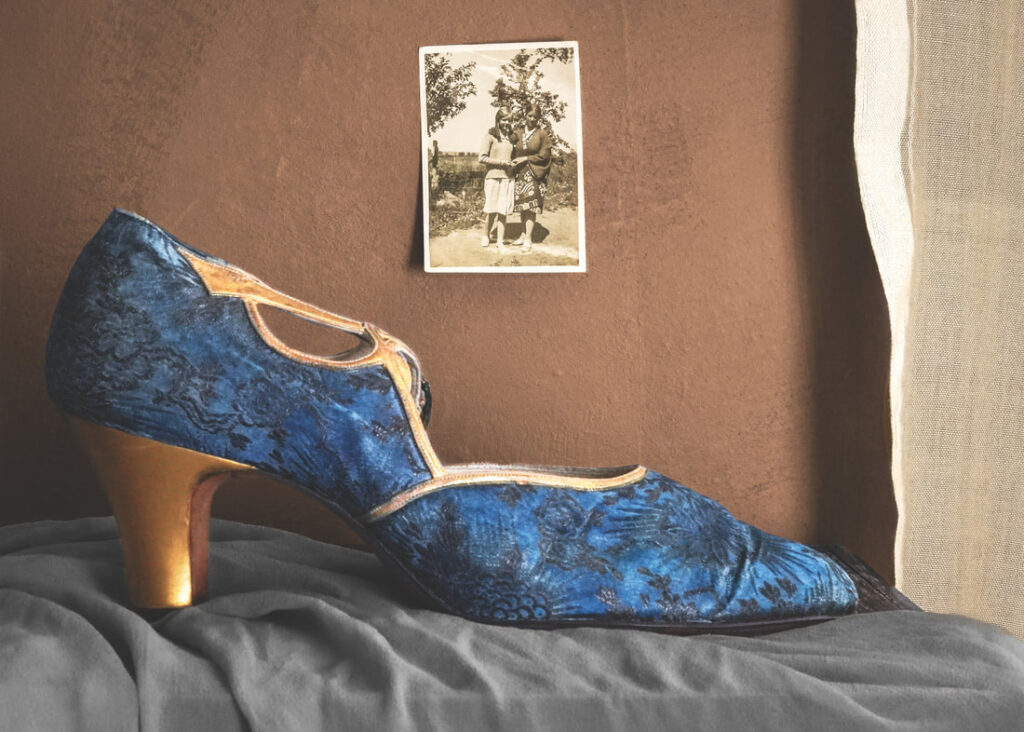
Zoë Zimmerman, Dancing Shoe, 2023. Photograph. Courtesy of Zoë Zimmerman and the Taos Art Museum.
Zoë Zimmerman grew up in and continues to live in Taos, New Mexico, where she began photographing at a young age. She studied photography at the Rhode Island School of Design, receiving a BFA in 1986. Her work is widely shown and collected nationally and internationally and is included in many public collections, including the Museum of Modern Art, the Harwood Museum, the Museum of New Mexico, the Harry Ransom Center for the Humanities, the Museum of Fine Arts, Houston, and others.

Zoë Zimmerman, Varnish and Stain, 2023. Photograph. Courtesy of Zoë Zimmerman and the Taos Art Museum.
Zimmerman’s photographs, as well as personal portraits and landscapes by Nicolai Fechin, are exhibited.
Click here for more information.
Millicent Rogers Museum (MRM): Painting from Within: 100 Years of Dorothy Brett in Taos
On view through October 30, 2024
The Millicent Rogers Museum is featuring Painting from Within: 100 Years of Dorothy Brett in Taos, an exhibition dedicated to presenting and honoring the legacy of Taos painter Dorothy Brett featuring works from numerous private collections in Taos, Santa Fe, and Albuquerque alongside pieces from the collection of the Millicent Rogers Museum.
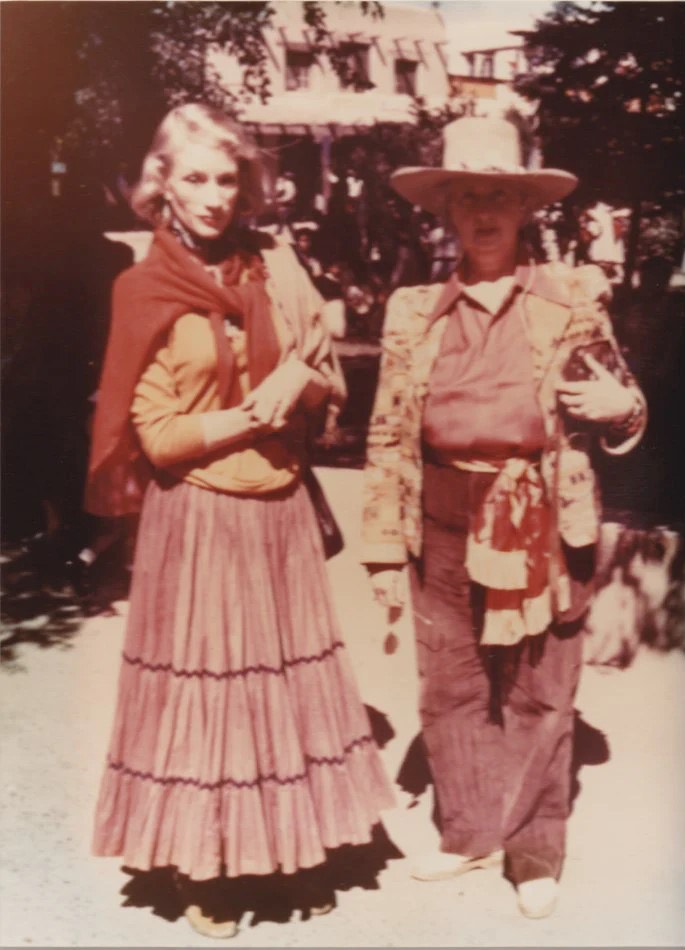
Millicent Rogers and Dorothy Brett. Photo courtesy of the Millicent Rogers Museum.
In 1924, the Honorable Dorothy Brett arrived in Taos. This trip to the American Southwest became the adventure that would go on to define her personal life and artistic career. Novelist D. H. Lawrence invited Brett to leave her life in England behind and find her new home in Taos.

Dorothy Brett, Taos Fiestas Panels, Dorothy Brett, Tom Benrimo, Rebecca James, Barbara Lantham, 1948, Oil on panel, Collection of the Millicent Rogers Museum.
The exhibition explores her portraits, landscapes, and collaborative pieces that compose the bulk of her Taos catalog. This exhibition seeks to present an authentic portrait of Dorothy Brett, not simply as the naive and adoring follower of D. H. Lawrence, but as an artist whose sensitive treatment in her paintings demonstrated her deep love of her adopted home. Her constant pursuit of beauty, much like the Museum’s namesake, and the representation of that beauty blossomed into a decades-long career that continues to this day.
Click here for more information.
Final Thoughts
There is plenty to do and see in Taos this autumn. Be sure to leave yourself time to dine, shop, and enjoy the views!
© 2024 Lenore Macdonald. All rights reserved.







